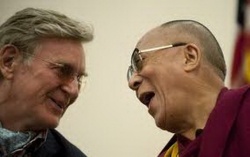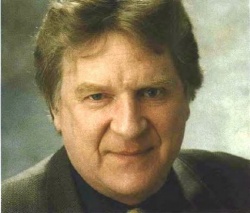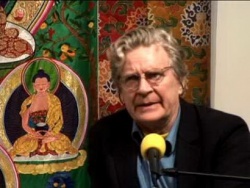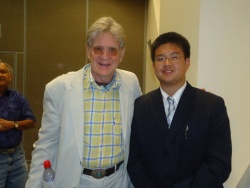Robert Thurman
Robert Alexander Farrar Thurman (born August 3, 1941) is an American Buddhist writer and academic who has written, edited or translated several books on Tibetan Buddhism. He is the Je Tsongkhapa Professor of Indo-Tibetan Buddhist Studies at Columbia University, holding the first endowed chair in this field of study in the United States. He also is the co-founder and president of the Tibet House New York and is active against the People's Republic of China's control of Tibet.
Life and career
Thurman was born in New York City, the son of Elizabeth Dean Farrar (1907–1973), a stage actress, and Beverly Reid Thurman, Jr. (1909–1962), an Associated Press editor and U.N. translator (French and English). He is of English, German, Scottish, and Irish ancestry. His brother, John Thurman, is a professional concert cellist who performs with the Detroit Symphony Orchestra., He attended Philips Exeter Academy from 1954 to 1958, followed by Harvard University, where he obtained his B.A., M.A. and Ph.D. degrees.
He married Marie-Christophe de Menil daughter of Dominique de Menil and John de Menil and heiress to the Schlumberger Limited oil-equipment fortune, in 1960; they had one daughter, Taya; their grandson was the late artist Dash Snow. In 1961 Thurman lost his left eye in an accident while he was using a jack to lift an automobile, and the eye was replaced with an ocular prosthetic.
After the accident he decided to refocus his life, divorcing his wife and traveling from 1961 to 1966 in Turkey, Iran and India. He became a Buddhist and was ordained in 1964, the first American Buddhist monk of the Tibetan Buddhist tradition. He studied with Tenzin Gyatso, the 14th Dalai Lama, who became a close friend.
In 1967, back in the United States, Thurman resigned his monk's vows of celibacy and married his second wife, German-Swedish model and psychiatrist Nena von Schlebrügge, who was previously married briefly to Timothy Leary. Thurman and Schlebrügge have four children, including actress Uma Thurman and Ganden Thurman, who as of 2012 is Executive Director of Tibet House.
Thurman obtained an M.A in 1969 and a Ph.D. in Sanskrit Indian Studies in 1972 from Harvard. He was professor of religion at Amherst College from 1973 to 1988, when he accepted a position at Columbia University as professor of religion and Sanskrit. At Amherst College Thurman met his lifelong friend Prof. Lal Mani Joshi, a distinguished Indian Buddhist scholar.
In 1987, Thurman created Tibet House U.S. with Richard Gere and Philip Glass at the request of the Dalai Lama. Tibet House is a nonprofit organization whose mission is to help preserve Tibetan Culture in exile. In 2001, the Pathwork Center, a 320-acre (1.3 km2) retreat center on Panther Mountain in Phoenicia, NY, was donated to Tibet House. Thurman and Schlebrügge renamed the center Menla Mountain Retreat and Conference Center. Menla (the Tibetan name for the Medicine Buddha) is being developed into a state-of-the-art healing arts center grounded in the Tibetan Medical tradition in conjunction with other holistic paradigms.
Ideas
Dr. Thurman is known for translations and explanations of Buddhist religious and philosophical material, particularly that pertaining to the Gelugpa (dge-lugs-pa) school of Tibetan Buddhism and its founder, Je Tsongkhapa.
Public reception
Time chose Robert Thurman as one of the 25 most influential Americans of 1997.
Thurman is considered a pioneering, creative and talented translator of Buddhist literature by many of his peers. Speaking of Thurman's translation of Tsongkhapa's Essence of Eloquence (Legs bshad snying po), Matthew Kapstein (professor at the University of Chicago and Ecole Pratique des Hautes Etudes in Paris) has written that, "The Essence of Eloquence is famed in learned Tibetan circles as a text of unparalleled difficulty. ... To have translated it into English at all must be reckoned an intellectual accomplishment of a very high order. To have translated it to all intents and purposes correctly is a staggering achievement." Similarly, prominent Buddhologist Jan Nattier has praised the style of Thurman's translation of the Vimalakīrti Sūtra, praising it as among the very best of translations of that important Indian Buddhist scripture.
Thurman's work has attracted some critics, however. In 2000, Toru Tomabechi, then a graduate student at the University of Lausanne, wrote that Thurman's popular, unannotated translation of the Pañcakrama contains "disastrous" mistakes and errors that betray "little trace of [the] minimal effort . . which we would naturally expect in any serious work of scholarship." Donald S. Lopez, Jr., Professor at the University of Michigan, has claimed that Thurman's work, "like so much of the work produced by American students of Tibetan Buddhism," shows "a bias that is both scholastic and Geluk."
In a 1996 interview for the Utne Reader, Thurman answers those critics who accuse him of idealizing pre-1959 Tibet:
- But to answer my critics who accuse me of trying to pretend that every Tibetan was an enlightened yogi, and they never even wiped their butts, and they didn’t have robbers and bandits and ignorant people, and they weren’t cruel ever — like it’s all just some sort of fantasy of mine, well, that isn’t at all the case. My thesis is a sociological one that has to do with mainstream social trends. The fact that a great majority of a country’s single males are monks rather than soldiers is a major social difference. Now, many of those monks might be nasty, they might punch people, some of them might pick your pockets, some of them might be ignorant. They might eat yak meat; they’re not out there petting the yaks. So I am in no way Shangri-La-izing Tibet when I try to develop a non-Orientalist way of appraising and appreciating certain social achievements of Tibet, which really tried to create a fully Buddhist society.
- But my opponents, who want to adopt the old British attitude that Tibet was dirty, grubby, and backward; or the modernist attitude that it’s a “premodern” undeveloped society; or the attitude of many other Buddhist countries that think Tibet was somehow degenerate because it was very Tantric, and Tantric Buddhism grows out of the degenerate period in India, well… I think these attitudes are mired in the idea that we modern Americans are the most advanced civilization the world has ever seen. I don’t think that’s the case. I consider us pretty barbaric.
Works
- The Central Philosophy of Tibet: A Study and Translation of Jey Tsong Khapa's 'Essence of True Eloquence' (Princeton Library of Asian Translations, Princeton University Press, 1991)
- The Tibetan Book of the Dead (Bantam Doubleday Dell, 1994)
- Essential Tibetan Buddhism, (Castle Books, 1995 ISBN 0-7858-0872-8)
- Wisdom and Compassion: The Sacred Art of Tibet (Abrams, 1996)
- Mandala: The Architecture of Enlightenment (Shambhala Publications, 1997)
- Worlds of Transformation: Tibetan Art of Wisdom and Compassion (Harry N. Abrams, 1999)
- Inner Revolution: Life, Liberty, and the Pursuit of Real Happiness (Penguin, 1999)
- The Holy Teaching of Vimalakirti: A Mahayana Scripture (translated by Robert Thurman, Pennsylvania State University Press, 2000, ISBN 0-271-01209-9)
- Circling the Sacred Mountain: A Spiritual Adventure Through the Himalayas co-authored with Tad Wise (Bantam Doubleday Dell, 1999)
- Infinite Life: Seven Virtues for Living Well (Riverhead Books, 2004, ISBN 1-57322-267-4)
- The Jewel Tree of Tibet: The Enlightenment Engine of Tibetan Buddhism (Free Press/Simon & Schuster, 2005)
- Anger (Oxford University Press, 2005, ISBN 0-19-516975-1)
- Why the Dalai Lama Matters: His Act of Truth as the Solution for China, Tibet and the World (Atria Books/Beyond Words, 2008, ISBN 1-58270-220-9)
Multimedia
- The Bob Thurman Podcast
- Journey with Robert Thurman in Bhutan
- Thurman, Robert (1999). Robert A.F. Thurman on Buddhism. DVD. ASIN B00005Y721.
- Thurman, Robert (2002). Robert Thurman on Tibet. DVD. ASIN B00005Y722.
External links
- Official website
- Why the Dalai Lama Matters Authorized web site
- Journey with Robert Thurman in Bhutan
- The Bob Thurman Podcast
- Video of an energetic talk about Buddhism and education at Columbia
- Thurman's Interview with the Dalai Lama in Mother Jones
- Bob Thurman: Becoming Buddha -- on the Web TED, Dec. 2006
- Video interview at City Arts & Lectures, 2009-03-05
- Global Lens Interview VIDEO
Source
Robert Alexander Farrar Thurman (born August 4, 1941 in New York City) is the Je Tsong Khapa Professor of Indo-Tibetan Buddhist Studies at Columbia University. He also is the co-founder and president of Tibet House New York and currently holds the first endowed chair in this field of study in the United States. He is the father of five children including the actress Uma Thurman.
Professor Thurman is highly-regarded for his lucid, dynamic translations and explanations of Buddhist religious and philosophical material, particularly that pertaining to the Gelugpa school of Tibetan Buddhism and its founder, Je Tsongkhapa including Tsongkhapa's Speech of Gold: Reason and Enlightenment in the Central Philosophy of Tibet, The Tibetan Book of the Dead, Essential Tibetan Buddhism, and Inner Revolution: Life, Liberty, and the Pursuit of Real Happiness.
At the age of 24, he became the first Western monk of the Tibetan Buddhist tradition. A close friend of His Holiness the 14th Dalai Lama, he has served as his occasional translator and has lectured all over the world.
The Translations and Writings of Robert Thurman
- The Central Philosophy of Tibet: A Study and Translation of Jey Tsong Khapa’s Essence of True Eloquence, Princeton University Press, 1984
- The Tibetan Book of the Dead, Bantam Doubleday Dell, 1994
- Wisdom and Compassion: The Sacred Art of Tibet, H. Abrams, 1996
- Tibetan Buddhism, HarperSanFrancisco, 1996
- Mandala: The Architecture of Enlightenment, Shambhala Publications, 1997
- Worlds of Transformation: Tibetan Art of Wisdom and Compassion, Harry N. Abrams, 1999
- Inner Revolution: Life, Liberty, and the Pursuit of Real Happiness, Penguin, 1999
- Circling the Sacred Mountain: A Spiritual Adventure Through the Himalayas, co-authored with Tad Wise, Bantam Doubleday Dell, 1999
- Infinite Life: Seven Virtues for Living Well, Riverhead Books, 2004
- The Jewel Tree of Tibet: The Enlightenment Engine of Tibetan Buddhism, Free Press, Simon Schuster, 2005
- Anger, Oxford University Press, 2005
- The Holy Teaching of Vimalakirti: A Mahayana Scripture, Pennsylvania State University Press, 2000



